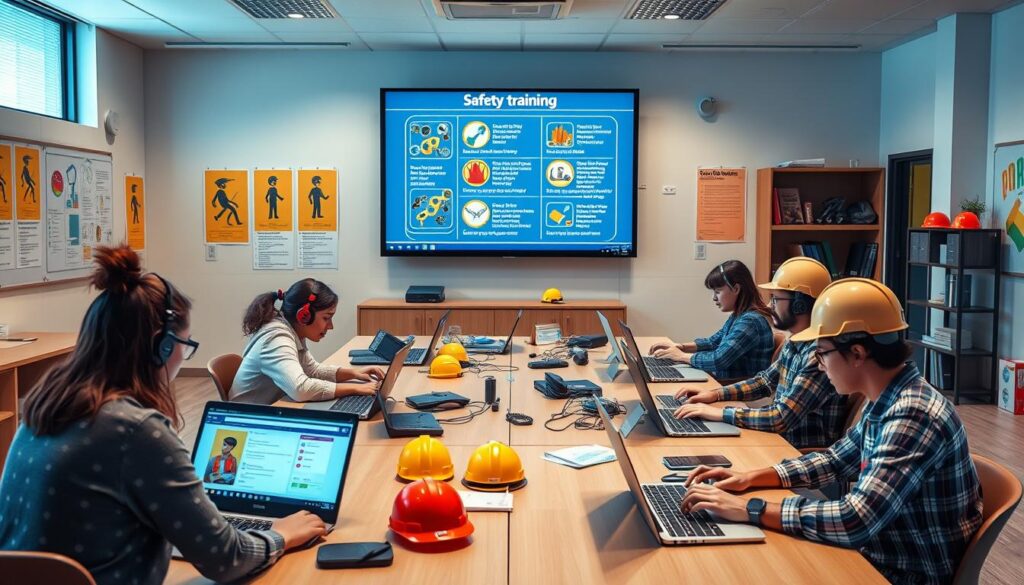The workplace is constantly changing, making safety training more critical than ever.
E-learning safety courses have become a key solution. They help organizations focus on employee safety while meeting legal standards and reducing risks.
In this detailed article, we’ll delve into the vital aspects of these training programs. We’ll discuss their role in the workplace, their benefits, and how to pick the best e-learning platform for your safety training needs.

Importance of Safety Training in the Workplace
Workplace safety is a critical concern for employers. It ensures compliance with regulations and helps mitigate risks. It also fosters a culture of safety awareness among employees. Proper safety training is essential for a safe and productive work environment.
Regulatory Compliance and Risk Mitigation
Compliance with regulations is a legal requirement and a key aspect of responsible business management. Proper safety training keeps organizations updated with industry standards. It minimizes the risk of costly fines, penalties, and legal challenges. Employers can protect their workforce and operations by addressing hazards and implementing safety protocols.
Fostering a Culture of Safety Awareness
Safety training is vital for creating a culture of safety awareness. When employees are trained to identify and mitigate risks, they become more engaged in risk management. This creates a sense of shared responsibility, empowering everyone to contribute to employee safety.
| Benefits of Effective Safety Training | Key Outcomes |
| Regulatory Compliance | Avoid fines and legal issues |
| Risk Mitigation | Reduce workplace accidents and injuries |
| Improved Safety Awareness | Empower employees to be proactive in safety |

Understanding E-Learning Safety Training Courses
E-learning has transformed safety training in organizations, offering a vibrant platform for employees to learn critical safety skills. At the core of these courses are interactive modules and multimedia content. These elements are crafted to engage learners and deepen their understanding of safety practices.
Interactive Modules and Multimedia Content
E-learning safety training courses include a variety of interactive modules, moving beyond traditional text-based learning. These modules might include:
- Immersive simulations that allow learners to navigate and respond to realistic safety scenarios
- Gamified quizzes and assessments that reinforce key safety concepts in a fun and engaging way
- Informative videos and animations that visually explain complex safety protocols and procedures
These interactive elements make e-learning platforms more dynamic and enriching. They help employees absorb safety information and develop the skills needed for a safe work environment.
Alongside these modules, e-learning safety training courses also feature a variety of multimedia content. This includes high-quality images, infographics, and podcasts. Such diverse materials cater to different learning styles, ensuring employees can engage with the content in a way that suits them best.
The blend of interactive modules and multimedia content enriches the learning experience. It provides a comprehensive approach to safety education. Employees gain the knowledge and tools needed to prioritize safety in their daily work.
| Feature | Benefit |
| Interactive Simulations | Immersive learning experiences that prepare employees for real-world safety scenarios |
| Gamified Assessments | Engaging and effective way to reinforce safety concepts and measure employee understanding |
| Multimedia Content | Caters to diverse learning styles and enhances the overall learning experience |
Investing in e-learning safety training courses with interactive modules and multimedia content fosters a culture of safety awareness. It ensures employees have the skills and knowledge to maintain a secure and compliant work environment.
Benefits of E-Learning Safety Training Courses
E-learning safety training courses bring numerous benefits to both companies and their employees. They are known for their flexibility and convenience, as well as their cost-effectiveness and scalability. These advantages make them a popular choice for many organizations.
Flexibility and Convenience
One major benefit of e-learning safety training is the flexibility it offers. Employees can access training materials at their convenience, anytime, and from anywhere. This eliminates the need for scheduling in-person sessions or traveling to specific locations. It allows employees to integrate training into their busy schedules, minimizing disruptions to their daily work.
Cost-Effectiveness and Scalability
Another significant advantage is the cost-effectiveness of e-learning safety training for employers. The initial investment in creating the course content is generally lower than the costs of organizing in-person training. Moreover, these courses can be easily scaled up or down to match the needs of the workforce. This makes them a flexible and efficient option for companies of all sizes.
| Benefit | Description |
| Flexibility and Convenience | Employees can access training materials at their own pace, anytime and anywhere, without the need for in-person sessions or travel. |
| Cost-Effectiveness and Scalability | E-learning courses are less expensive to develop and can be easily scaled up or down to meet changing workforce needs. |

“E-learning safety training courses offer a convenient and cost-effective way for companies to provide essential safety education to their employees.”
E-Learning Safety Training Programs: Key Information You Should Have
In today’s fast-paced workplace, e-learning safety training courses are crucial. They help create a culture of safety awareness and compliance. These digital solutions provide a comprehensive way to equip employees with the necessary knowledge and skills for workplace safety.
E-learning safety training courses cover a wide range of topics. They include basic workplace hazard identification and specialized training for high-risk industries. These courses use interactive modules and multimedia content to make learning engaging. This helps employees remember important safety information.
The flexibility and convenience of e-learning safety training courses are significant. Employees can access these courses at their own pace. This fits easily into their schedules and reduces the need for in-person training sessions.
Additionally, e-learning safety training courses are cost-effective and scalable. Employers can use digital platforms to streamline their safety training efforts. This allows them to reach a larger workforce with consistent, high-quality content while saving on expenses.
“E-learning safety training courses are not only a practical solution but a strategic investment in the well-being of our employees and the overall success of our organization.”
E-learning safety training courses are a powerful tool in today’s workplace. They empower employees, foster a culture of safety, and ensure regulatory compliance. By understanding these solutions, organizations can make informed decisions that prioritize their workforce’s safety and well-being.
Choosing the Right E-Learning Platform
Choosing the right e-learning platform is key to your organization’s safety training success. When looking at different platforms, several factors stand out. First, the platform must deliver interactive and engaging content. This content should effectively raise safety awareness among your employees.
Another critical aspect is the platform’s flexibility and scalability. It should meet your specific safety training needs now and in the future. A user-friendly interface and seamless integration with your systems also enhance the learning experience for your employees.
Lastly, the platform’s reporting and analytics capabilities are vital. Strong data and analytics tools offer insights into your safety training program’s effectiveness. This allows you to make informed decisions and improve your approach. By carefully considering these factors, you can find an e-learning platform that supports your safety goals and promotes a culture of safety awareness.
